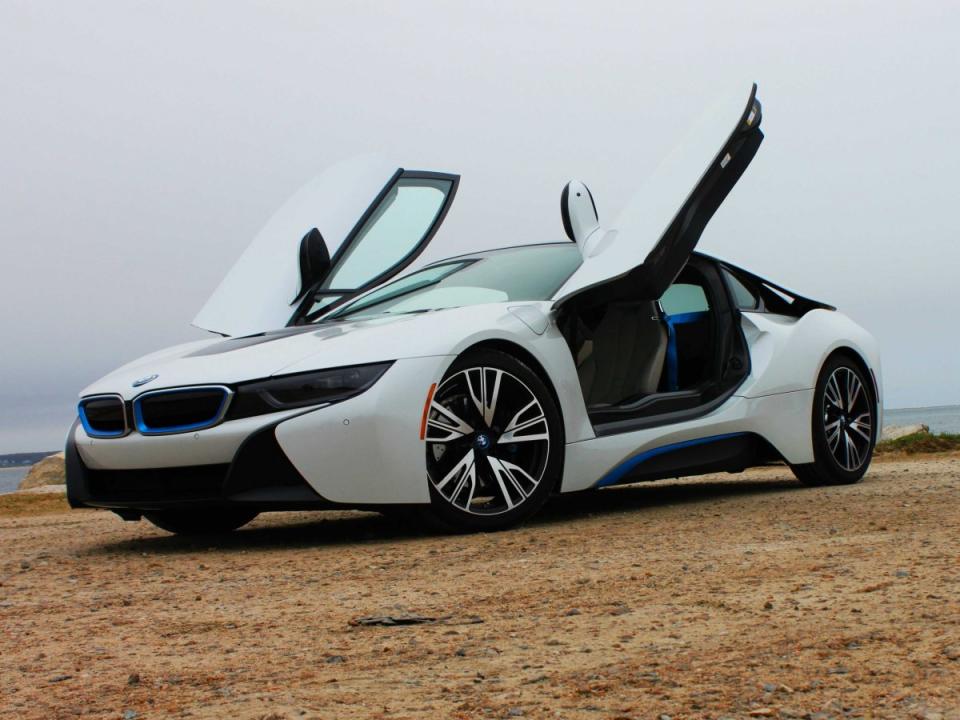The BMW i8 is the sports car of the future, and we drove it through America's past

The BMW i8 is a technological tour de force. It's a twin-engine, plug-in hybrid with show-car looks, supercar performance, and economy-car efficiency. It's BMW's vision for what the future may hold for sports cars. Recently, BMW lent Business Insider a white i8, and we took it on a road trip through historic New England.
As a plug-in hybrid sports car, BMW i8 is unlike anything on the road today.

Sure, there are other high-performance hybrids out there, such as the Porsche 918 ...

... the McLaren P1 and ...

... the Ferrari LaFerrari. But these are million-dollar exotic hypercars.

The i8, on the other hand, starts at a somewhat more attainable $136,500.

At the heart of the i8 is a hybrid powertrain. Up front is a 129-horsepower electric motor powering the front wheels. In back, a 228-horsepower turbocharged three-cylinder engine that drives the rear wheels. Together, they form a "virtual" all-wheel-drive system.

Sadly, you're out of luck if you want to see the powerplant. It's hidden behind a bolted engine cover — seen here in Saabkyle04's i8 walkthrough on YouTube. Unless you're a BMW service technician, you won't get to see the engine.

According to BMW, the i8 is good for zero to 60 in 4.2 seconds, although that stat seems a bit conservative based on our experience with the car. In fact, Car and Driver managed to achieve that in 3.6 seconds.

Which means, based on price and performance, its contemporaries are such industry stalwarts as the Porsche 911 Carrera ...

... the Jaguar F-Type ...

... the Audi R8 and ...

... even the new Mercedes-AMG GT.

Driving the i8, we set off from Northern New Jersey for the Connecticut coast.

Immediately, the BMW's futuristic looks caught the eyes of our fellow motorists. In fact, many thought the i8 was a prototype that somehow managed to find its way onto public roads.

That's a reasonable assumption. The i8 production car is based on the i8 concept, and as you can see, they look remarkably similar.

The i8's design is also inspired by BMW's legendary M1 supercar of the 1970s.

Along with the i3 city car, the i8 forms BMW's high-tech "i" division.

On the highway, the i8 proved to be comfortable. Its hybrid electric powertrain is incredibly responsive when called upon to provide an extra burst of power for passing.

Cruising down the highway, the i8 will run under both gas and electric power. But once the battery is charged, the car can go into full electric mode.

In eDrive mode, the i8 can go up to 15 miles at a max speed of 75 mph, under only electric power.

Sport mode unleashes the i8's full performance potential — allowing the engine to maintain higher revs. Although Sport mode is the quickest way to charge the batteries, it's also the quickest to drain the car's gas tank.

However, the i8 was most at home when cruising at 65-75 mph in Comfort mode.

On New England's winding country roads, the BMW's finely tuned chassis and superstrong carbon-fiber construction made the i8 a confident performer around the corners.

Although the i8's 357 horsepower is modest by modern sports car and supercar standards, the car's torquey engines never once left me wanting for more power.

After a couple of hours on the road, we made our first stop to shoot photos near the lighthouse in the town of Stonington, Connecticut.

And there we encountered the only real complaint we had with the i8 — getting in and out of it. It's a chore.

The proper technique for getting in the car involves an extended procedure that calls for you to sit on the door sill, slide your butt back into the seat, then swing your legs under the steering wheel. In short, there's really no elegant way to get in and out of the i8.


 Yahoo Autos
Yahoo Autos 
